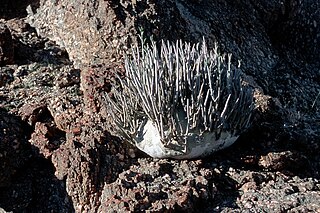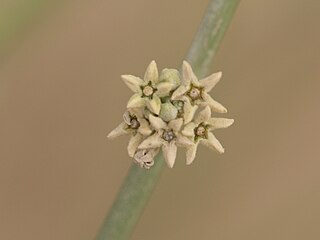
Cyamopsis is a genus of the family Fabaceae. Its species are distributed across sub-Saharan Africa, Saudi Arabia, Pakistan, and India. Typical habitats include tropical seasonally-dry thorn scrub and grassland, often in floodplains, stream beds, and pans, and in open sandy or rocky areas.

Adenia is a genus of flowering plants in the passionflower family Passifloraceae. It is distributed in the Old World tropics and subtropics. The centers of diversity are in Madagascar, eastern and western tropical Africa, and Southeast Asia. The genus name Adenia comes from "aden", reported as the Arabic name for the plant by Peter Forsskål, the author of the genus.

Calpurnia is a genus of flowering plants within the family Fabaceae. It includes six species which range through eastern, central, and southern Africa and in southern India. The genus comprises shrubs or small trees in or along the margin of forests in the eastern parts of South Africa. They shed leaves in winter unless in moist areas, where they are evergreen. They make good garden plants because they are easily raised from seed, flower at two years and withstand frost.

Millettia is a genus of flowering plants in the family Fabaceae. It consists of about 169 species of shrubs, lianas or trees, which are native to tropical and subtropical regions of sub-Saharan Africa, the Indian subcontinent, Indochina, southern China, Malesia, and New Guinea. Typical habitats include tropical rain forest and seasonally-dry lowland and upland forest and forest margins, woodland, thicket, wooded grassland, and secondary vegetation.

Melhania is a genus of small shrubs or herbaceous plants. Traditionally included in the family Sterculiaceae, it is included in the expanded Malvaceae in the APG and most subsequent systematics. The genus is named for Mount Melhan in Yemen.

Trianthema is a genus of flowering plants in the ice plant family, Aizoaceae. Members of the genus are annuals or perennials generally characterized by fleshy, opposite, unequal, smooth-margined leaves, a prostrate growth form, flowers with five perianth segments subtended by a pair of bracts, and a fruit with a winged lid. The genus contains about 30 described species growing in tropical and subtropical regions, especially Australia. One common species, Trianthema portulacastrum, desert horse purslane, is frequent as a weed in agricultural areas and is widely distributed.

Utricularia scandens is a small, probably annual carnivorous plant that belongs to the genus Utricularia. It has a wide native distribution that includes Africa and Asia. U. scandens grows as a terrestrial plant in wet grasslands and bogs at lower altitudes around sea level up to 2,300 m (7,546 ft). It was originally described by Ludwig Benjamin in 1847. There is a significant amount of synonymy established for this species, in part because of its large distribution and variable morphology.

Harpochloa is a genus of African plants in the grass family, common name caterpillar grass.

Albuca is a genus of flowering plants in the family Asparagaceae, subfamily Scilloideae. The genus is distributed mainly in southern and eastern Africa, with some species occurring in northern Africa and the Arabian Peninsula. Plants of the genus are known commonly as slime lilies.

Hessea is a genus of bulb-forming plants in the Amaryllis family native to Namibia and South Africa. The genus name commemorates C. H. F. Hesse (1772–1832), who resided in Cape Town from 1800 to 1817.
Gongronema is a genus of plants first described as a genus in 1844. Some of the species are native to Africa, with others in South and Southeast Asia.

Tavaresia is a genus of plants in the family Apocynaceae, first described as a genus in 1902. It is native to southern Africa.
- Tavaresia angolensisWelw. - Angola
- Tavaresia barklyi(Dyer) N.E.Br. - South Africa
- Tavaresia grandifloraBerger - South Africa
- Tavaresia meintjesiiR.A. Dyer - Limpopo
Eustegia is a genus of vines in the family Apocynaceae, first described as a genus with this name in 1810. It is native to southern Africa.
- Eustegia filiformis(L.f.) Schult.
- Eustegia fraternaN.E.Br.
- Eustegia hastata(Thunb.) R. Br. ex Schult.
- Eustegia macropetalaSchltr.
- Eustegia minuta(L.f.) N.E.Br.
- Eustegia plicataSchinz

Leptadenia is a genus of plants in the family Apocynaceae, first described as a genus in 1810. It is native to Africa, including Madagascar, as well as southwest Asia and the Indian Subcontinent.
- Leptadenia arborea(Forssk.) Schweinf. - Sudan, Ethiopia
- Leptadenia lancifolia(Schumach. & Thonn.) Decne. - tropical Africa
- Leptadenia madagascariensisDecne. - Madagascar
- Leptadenia pyrotechnica(Forssk.) Decne. - widespread from Algeria to India
- Leptadenia reticulata(Retz.) Wight & Arn. - Madagascar

Pachycarpus is a genus of plants in the family Apocynaceae, first described in 1838. It is native to Africa.
Oncinema is a genus of plants in the family Apocynaceae first described as a genus in 1834. It contains only one known species, Oncinema lineare , native to South Africa.
Pentatropis is a genus of plants in the family Apocynaceae, first described as a genus in 1834. It is native to Africa and southern Asia.

Petalidium, commonly known as petal-bushes, is a genus of perennial shrubs in the acanthus family. They are native to sandy flats or stony slopes in the drier bush regions of Africa, India and the Mascarene Islands. The majority of species occur in frost-free, summer rainfall regions of southern Africa, and may be found from low to medium altitudes.

Euphorbia schinzii is a perennial Southern African, dwarf flowering plant belonging to the family Euphorbiaceae. It is found on rocky slopes, growing among rocks. Variable in form, it occurs in South Africa, Zimbabwe, Botswana, Mozambique and Malawi, at an altitude between 100 and 1500 meters. The genus Euphorbia is large, with over 2000 species of extremely diverse size and appearance, and with a global distribution.















